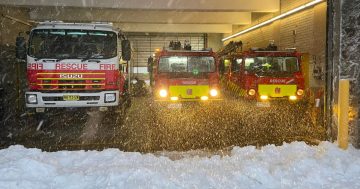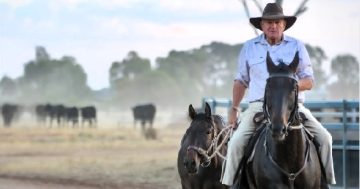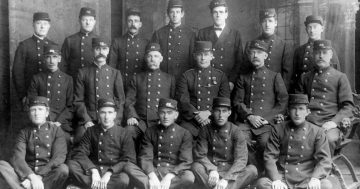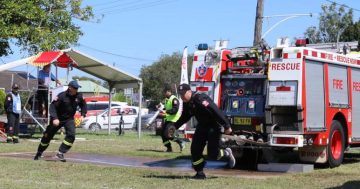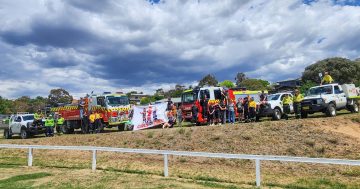
Professional firefighters hand out leaflets at Goulburn’s pre-polling booth on Monday morning. Photo: John Thistleton.
NSW firefighters are campaigning outside the pre-polling booth in Goulburn for additional firefighters and station upgrades.
They have joined colleagues in regional areas campaigning for 600 additional firefighters and $350 million to upgrade stations that have not been keeping pace with modern-day facilities. They say instead of keeping pace with demand, the Government is threatening to close up to 30 stations.
Their union says handing out leaflets outside their work hours is the last thing the firefighters wanted to do, but members are fed up and frustrated.
“They would rather be at home with their families or trying to come off their shiftwork and have some rest,” Fire Brigade Employees Union secretary Leighton Drury said.
“Instead they are trying to make changes to highlight in the communities they protect there are problems in the fire service.
“In regional NSW we live in the communities that we protect, we know the people walking down the street and at the calls that we go to. So we think it’s important that the community hears our message on these things.”
The union says the population of NSW has grown by nearly one million people over the past decade and the Coalition Government has not added a single firefighter to the NSW Fire Service in that time.
“We’re actually behind by 76 and the first extra firefighters we received in the last decade were the 30 that went to Oran Park two weeks ago, when they opened that station, interestingly enough, a month out from the state election,” Mr Drury said. “Even with those 30, we are roughly 40 behind on what we were 10 years ago.”
Mr Drury says the state’s demographic had changed as a result of COVID-19, with more people leaving metropolitan areas and moving to rural centres.
Firefighters are handing out material in the electorates of Goulburn, Wollondilly, Camden, Leppington, Heathcote, Port Stephens, Upper Hunter and Tweed.
“We have 500,000 new homes being built in the last 10 years,” Mr Drury said. He said in addition to protecting homes, firefighters were called on for many other types of emergency work.
“We do rescue, road-crash rescue, industrial rescue, high angle, swift water, hazardous materials, bushfires, floods and our day-to-day business as well,” he said.
At times, firefighters are called out more often to help ambulance officers than to actual fires.
“During COVID, when the ambulance was stretched, we would get called out to help, put people on trolleys, take them out of their houses,” Mr Drury said.
The normal overtime bill pre-COVID for firefighters should generally be $20 million, but this year it is heading towards $90 million. “That’s how short we are across the state at the moment, especially regional NSW,” the union secretary said.
Fire trucks and stations were not fit for purpose. Most of the stations did not have separate facilities for men and women, or enough showers.
Mr Drury said the World Health Organisation had determined firefighting will give you cancer, so decontamination after attending fires is critical. But other than the exceptional new fire station, there were too few showers.
“We can’t see a way forward with the current Government. We have asked for a range of things from both (major) parties: 600 new permanent firefighters, 300 more retained firefighters, $350 million over eight years to bring our stations up to standard,” Mr Drury said.
“The only commitment we have is from the Opposition, that was 600 permanent new positions over coming years. We have had good support from the Shooters Fishers and Farmers, the Greens, the independents, but we have not got any commitment from the Liberal or National parties.”
Minister for Emergency Services and Resilience Steph Cooke said in the 2022-23 Budget, the NSW Liberal and Nationals Government invested more than $4.2 billion in emergency services, including a record $970.2 million for Fire and Rescue NSW, which is a $122.2 million increase on the previous year.
Ms Cooke said in the past year alone, 415 permanent and on-call firefighters had joined the ranks of Fire and Rescue NSW.
“The NSW Liberal and Nationals Government will continue to ensure our emergency services organisations have the resources and staff they need to keep communities safer and stronger,” she said.







